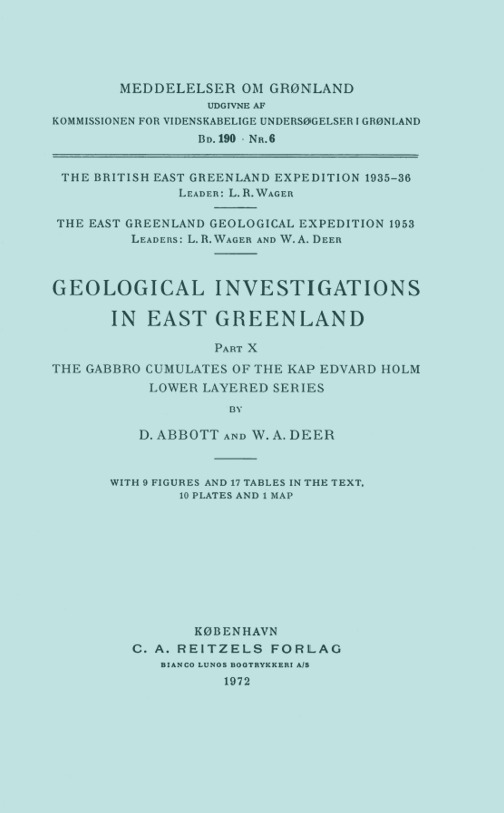Geological Investigations in East Greenland. Part X.
DOI:
https://doi.org/10.7146/mog.v190.150332Abstract
The Kap Edvard Holm complex, situated on the west side of the Kangerdlugssuaq, is one of the major units of the east Greenland Thulean igneous province. The largest part of the complex consists of layered gabbros that, like the Skaergaard intrusion, were emplaced after the formation of the early Tertiary basalts but prior to the large monoclinal coastal flexure. Subsequently the layered gabbros were intruded by the syenites of Kap Deichmann and Kap Boswell. Three separate and major injections of basic magma were involved in the formation of the layered complex, and gave rise to an earlier, Lower Layered Series to the north, a Middle Layered Series occupying the central, and a later Upper Layered Series in the southern part of the complex. The present contribution is concerned solely with the earliest basic rocks of the complex, the Lower Layered Series, which form a group of rhythmically banded cumulates some 3900 m in thickness. There is no chilled margin exposed and at the only locality in which the Lower Layered Series are exposed close to the Pre-Cambrian gneisses, an earlier fine-grained marginal gabbro, 100 m in thickness, lies between the rocks of the layered series and the gneisses. The mineralogy of the series is described and includes details of the plagioclase zoning at various heights in the layered succession, the compositional trends of the clinopyroxenes and olivines, and also some details of the primary and secondary amphiboles, and of the iron oxides. Orthopyroxene does not occur, either as a cumulus or interculus phase in the rocks of the layered series. The Lower Layered Series is divided into a lower and an upper unit, the Lower Zone A and Lower Zone B cumulates respectively. The lower unit has a maximum thickness of 700 m and consists of plagioclase-augite-olivine orthocumulates and includes both extreme feldspar- and ferromagnesian-rich bands. The chemical composition of Lower Zone A is illustrated by three analyses of the cumulates and includes that of a feldspar adcumulate layer. Lower Zone B is 3200 m in thickness and displays progressive cryptic layering from the base of the zone upwards in the succession for 1300 m. Above this level, at a height of 2050 m in the layered succession, the trend of the cryptic layering is reversed, and these higher cumulates, the composition of which are illustrated by eight analyses, show progressively decreasing mafic and felsic
indices. The deduced composition of the original magma from which the cumulates crystallized is compared with the initial chilled margin of the Skaergaard intrusion. The Lower Layered Series magma is less tholeiitic in character than that of the Skaergaard, and has affinities with transitional alkali olivine basalt magma.

Downloads
Published
How to Cite
Issue
Section
License
Coypyright by the authors and the Commision for Scientific Research in Greenland. No parts of the publications may be reproduced in any form without the written permission by the copyright owners.

